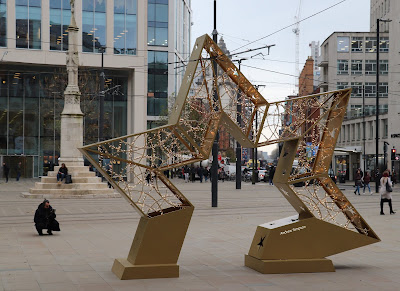Now I never visited the Swan With Two Necks on Withy Grove and now I never will.
According to one source it had been doing the business of serving up beer from 1795 and certainly twenty years earlier there had been a building on the site.*
By 1821 the landlady was a Lydia Oliver who was still there in 1827 and according to the rate books owned property in the surrounding streets.
The rateable value of the pub was £100 in 1823 and this far exceeded the rates of other buildings on the road and puts the other pub just a few doors down in the shadows. This was run by Alice Wilmott who is listed as paying just £45 for the front two rooms of no 5 Withy Grove.
All of which makes Ms Oliver an interesting person to research, but for now all I know is that she was dead by 1841 because her properties are recorded as being managed by Executors.
There is a reference to a Lydia Oliver who was buried in Cheetham in September 1838 and whose death was registered by the Chorlton Union a few days earlier.
If this is our Ms Oliver, she had been born in 1765 and was 73 at her death.
So I shall return to the pub which vanished only relatively recently and is now the site of a takeaway business.
Back in the 1820s the pub was simply known as the Swan and I shall go looking for just when it gained that extra neck but it was trading with that new name by 1844 and in 1911 was run by a the Kinaman family.
Martin Kinaman was 51, and from Ireland and had been married to Clara Ann for twenty one years.
They had five children of whom the eldest Claire Kathleen at 19 was serving as a barmaid and that April of 1911 they shred the six roomed property with Amy Gough who was 31, from Manchester and described herself as a “housekeeper.”
And for those who want to know more about the pub in more recent times that excellent site Pubs of Manchester has a good description which should be read in conjunction with the four photographs of the pub since 1959 on the local image collection.
These later pictures are themselves facinating for showing the transfoirmation from traditional exterior to one in keeping with the 1970s.
Location; Manchester
Pictures; Swan with Two Necks, 1980s from the collection of John Casey, the pub in 1959 by H W Beaumont, m50619, courtesy of Manchester Libraries, Information and Archives, Manchester City Council, http://images.manchester.gov.uk/index.php?session=pass and in 1970 by A Davison, m50620, and map showing the pub in 1851 from Adshead’s map of Manchester 1851, courtesy of Digital Archives Association, http://digitalarchives.co.uk/
*Pubs of Manchester, http://pubs-of-manchester.blogspot.co.uk/2010/01/swan-with-two-necks-withy-grove.html
 |
| Swan With Two Necks, 1980s |
By 1821 the landlady was a Lydia Oliver who was still there in 1827 and according to the rate books owned property in the surrounding streets.
The rateable value of the pub was £100 in 1823 and this far exceeded the rates of other buildings on the road and puts the other pub just a few doors down in the shadows. This was run by Alice Wilmott who is listed as paying just £45 for the front two rooms of no 5 Withy Grove.
 |
| Swan With Two Necks, 1851 |
There is a reference to a Lydia Oliver who was buried in Cheetham in September 1838 and whose death was registered by the Chorlton Union a few days earlier.
If this is our Ms Oliver, she had been born in 1765 and was 73 at her death.
So I shall return to the pub which vanished only relatively recently and is now the site of a takeaway business.
 |
| Swan With Two Necks, 1959 |
Martin Kinaman was 51, and from Ireland and had been married to Clara Ann for twenty one years.
They had five children of whom the eldest Claire Kathleen at 19 was serving as a barmaid and that April of 1911 they shred the six roomed property with Amy Gough who was 31, from Manchester and described herself as a “housekeeper.”
 |
| The Swan With Two Necks, 1970 |
These later pictures are themselves facinating for showing the transfoirmation from traditional exterior to one in keeping with the 1970s.
Location; Manchester
Pictures; Swan with Two Necks, 1980s from the collection of John Casey, the pub in 1959 by H W Beaumont, m50619, courtesy of Manchester Libraries, Information and Archives, Manchester City Council, http://images.manchester.gov.uk/index.php?session=pass and in 1970 by A Davison, m50620, and map showing the pub in 1851 from Adshead’s map of Manchester 1851, courtesy of Digital Archives Association, http://digitalarchives.co.uk/
*Pubs of Manchester, http://pubs-of-manchester.blogspot.co.uk/2010/01/swan-with-two-necks-withy-grove.html













































